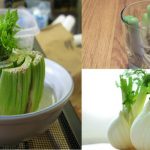Did you know that some of vegetable and fruit residues can actually be used to produce more plants?
Most of you think that produce residues are only good for compost, but the fact is they can be used to plant and grow the same types of veggies and fruits.
These are the seven most popular plants that our team has selected, and they may be easily re-grown from their residues:
- Onion
Plant an onion which has already begun to sprout at a depth of about 1 cm and place it in a sunlit spot. Water it if necessary. There should be enough water, but not too much since the root can decay. You will notice new slips emerging in no time. When it begins to form cocksfoot, the water quantity should be reduced.
- Garlic
Great deal of the garlic that can be found in our green markets originates in China, which most often is sprayed with chemicals so that it is conserved and can travel thousands of miles across the globe. Therefore, if you want healthy, organic garlic in your diet, you should simply plant it on your own!
Although the best time for planting garlic is late summer or fall, it can still be planted at any time around the year. Like onion, this plant also wants wet conditions, so it is best to provide a nylon or straw cover which will keep the moisture inside.
Garlic can improve the growth of these plants: tomatoes, lettuce, raspberries, strawberries, beets and roses. But you should keep it at distance from beans or peas.
Planting: Make a hole in the soil, about 5 cm in depth. Plant the clove with its root faced down. After a while, there will appear new, young slips.
- Potato
You can grow both: white and sweet potatoes. If the potatoes have already sprouted, leave them at room temperature, slightly dehydrated. Or, in case the sprouted potato is bigger, cut it into to 2-3 parts making sure all parts have sprouted.
Plant the parts shallow in a pot. When you notice that their roots are growing, add another layer of earth. Sweet potatoes also easily sprout, but you should plant them deeper in the pot.
- Lettuce
Set the lettuce in a bowl of water along with its root. The water should be changed every day. Occasionally you can spray the leaves to keep the moisture in them. The lettuce also needs a sunny spot. You will notice how quickly it can grow. In just two days, you will have new leaves.
- Celery
Similarly to salad lettuce, inside the celery about 2-3 cm above the root and put it in a bowl well filled with water. New leaves will start popping up if you put the dish in a nice, sunny spot. It should be sprayed with water for 1-2 weeks.
- Cabbage
Place the cabbage with its root in a bowl with water, taking care not to soak the leaves, so they do not go rot. Do not forget to change the water in the bowl every day. Like with the lettuce, spray it with water 1-2 times a week, and keep it in a sunny place away from pollution.
- Pineapple
Cut the top (or the crown) and remove the fruit’s flesh. Leave only 2.5 cm flesh around the base. Plant it in a warm place with regular, adequate irrigation, or put it in a glass of water.
When the plant starts growing, regular watering should be done once a week. Pineapple requires patience because the first result will appear in at least one year.
Do not be a slacker: invest in your health and save money. Get in the habit of recycling your produce for your own sake!




